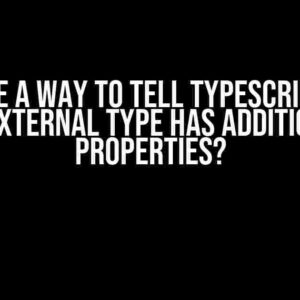Ah, the thrill of the chase! You’ve finally mastered the art of using React Hook Form’s useFieldArray hook to manage complex form structures. But, just as you thought you’d conquered the kingdom of form validation, a pesky error creeps up, refusing to be tamed. The error state, once so obedient, now refuses to update, leaving you scratching your head and wondering what sorcery is at play. Fear not, dear developer, for we’re about to embark on a journey to uncover the secrets behind the “React Hook Form Field Array Custom Refine Error State Won’t Update” conundrum. Buckle up, because we’re about to dive deep into the heart of this enigmatic issue!
Understanding the Problem
Before we dive into the solution, let’s take a step back and understand the problem at hand. When using useFieldArray, you’re probably using a custom validation function to refine the error state of your form fields. This is where things get tricky. Sometimes, even when your validation function correctly identifies errors, the error state won’t update, leaving your users stuck in a frustrating loop of uncertainty.
The Usual Suspects
Before we get into the meat of the solution, let’s quickly rule out some common culprits that might be causing this issue:
useEffectnot being used correctly: Make sure you’re usinguseEffectto re-run your validation function when the form data changes.- Invalid or missing
nameprop: Double-check that you’re passing a validnameprop to your form fields. - Inconsistent state updates: Verify that your state updates are happening correctly and not being overridden by other parts of your code.
If you’ve checked all these boxes and the issue still persists, it’s time to dig deeper.
Uncovering the Root Cause
The primary culprit behind this issue lies in the way React Hook Form handles the error state of field arrays. By default, React Hook Form uses a shallow comparison to determine if the error state has changed. This means that even if your custom validation function returns a new error object, React Hook Form might not detect the change if the reference to the error object remains the same.
To illustrate this, let’s take a look at an example:
import { useFieldArray } from 'react-hook-form';
const MyForm = () => {
const { register, control, errors } = useForm();
const { fields, append, remove } = useFieldArray({
control,
name: 'items',
});
const validateItems = (items) => {
const errors = {};
items.forEach((item, index) => {
if (!item.name) {
errors[index] = { name: 'Required' };
}
});
return errors;
};
const handleSubmit = async (data) => {
const errors = validateItems(data.items);
// ...
};
return (
);
};
In the above example, even though our validateItems function returns a new errors object, React Hook Form might not detect the change if the reference to the errors object remains the same.
The Solution
So, how do we update the error state correctly? The answer lies in using a technique called “object merging” to ensure that React Hook Form detects the changes to the error state. We’ll create a new function that merges the new error object with the existing one, ensuring that the reference changes and triggers an update:
const updateErrorState = (newErrors) => {
setErrors((prevErrors) => ({ ...prevErrors, ...newErrors }));
};
Now, let’s modify our handleSubmit function to use the updateErrorState function:
const handleSubmit = async (data) => {
const errors = validateItems(data.items);
updateErrorState({ items: errors });
// ...
};
Putting it all Together
Here’s the complete code with the fix:
import { useFieldArray } from 'react-hook-form';
import { useState } from 'react';
const MyForm = () => {
const { register, control, errors, setErrors } = useForm();
const { fields, append, remove } = useFieldArray({
control,
name: 'items',
});
const validateItems = (items) => {
const errors = {};
items.forEach((item, index) => {
if (!item.name) {
errors[index] = { name: 'Required' };
}
});
return errors;
};
const updateErrorState = (newErrors) => {
setErrors((prevErrors) => ({ ...prevErrors, ...newErrors }));
};
const handleSubmit = async (data) => {
const errors = validateItems(data.items);
updateErrorState({ items: errors });
// ...
};
return (
);
};
Conclusion
And there you have it! With this fix, your React Hook Form field array custom refine error state should now update correctly. Remember, the key is to use object merging to ensure that the reference to the error state changes, triggering an update in React Hook Form. By following these steps, you’ll be able to tame the beast of uncooperative error states and provide a seamless user experience for your users.
| Solution | Description |
|---|---|
| Use object merging | Update the error state by merging the new error object with the existing one, ensuring a change in reference. |
Use setErrors correctly |
Use the setErrors function from useForm to update the error state. |
| Avoid shallow comparisons | Ensure that React Hook Form detects changes to the error state by using object merging. |
By following these guidelines and understanding the root cause of the issue, you’ll be well on your way to mastering the art of React Hook Form field array custom refine error state management. Happy coding!
Here are 5 Questions and Answers about “react-hook-form field array custom refine error state won’t update” in a creative voice and tone:
Frequently Asked Questions
Get the scoop on common React Hook Form field array conundrums!
Why isn’t my custom error state updating when I refine the field array?
When you refine a field array, React Hook Form only updates the error state if the entire field array is re-rendered. If you’re only updating a single item within the array, the error state won’t automatically update. You need to manually update the error state by calling `setError` or `setErrors` with the new error information. Talk about a field day for debugging!
How do I properly update the error state when refining a field array?
To update the error state, you’ll need to create a custom function that refines the field array and then calls `setError` or `setErrors` to update the error state. You can also use the `useForm` hook to access the `getValues`, `getError`, and `setErrors` methods to help you update the error state. Think of it as a dance between refining the array and updating the error state – they need to be in sync!
What’s the difference between `setError` and `setErrors` when updating the error state?
`setError` sets a single error message for a specific field, while `setErrors` sets an object of error messages for multiple fields. When refining a field array, you might need to update multiple error messages, so `setErrors` is usually the better choice. Think of it like sending a single error message versus sending a batch of error messages – `setErrors` is the bulk update winner!
Can I use `useCallback` to memoize the custom refine function and improve performance?
Yes, you can use `useCallback` to memoize the custom refine function, which can help improve performance by preventing unnecessary re-renders. By memoizing the function, you ensure it’s only created once and reused when the dependencies don’t change. This optimization technique is like having a superpower – it’s a performance booster!
What’s the best way to handle complex validation logic when refining a field array?
When dealing with complex validation logic, consider using a separate validation function that takes the refined field array as an input. This function can then perform the necessary validation and return an error object or array. By separating the validation logic, you can keep your custom refine function lean and mean, making it easier to debug and maintain. It’s like having a validation ninja on your team – swift and stealthy!



